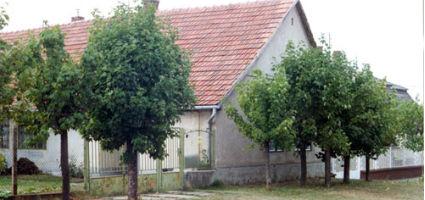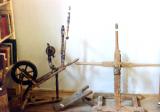2025. July 11. Friday
Csonka-tower Foundation - Region History Exhibition - Soltszentimre
 |
Address: 6223, Soltszentimre Hunyadi u. 17.
Phone number: (78) 445-253
E-mail: cstorony@freemail.hu
Opening hours: On prior notice
|
The region between the Danube and Tisza always attracted the settlers. Before the Foundation of the State nomad pastors, from the middle of the 2nd century people who cultivated plans and different type of artisans spread on the area.
At the time of the original settlement, this region was occupied. The tenants did not live in large numbers and probably were engaged in shepherding.
At the time of the Romans a 'castrum', a watchtower stood at the place of the Csonka (lame) Tower. The decree of King Stephen stated that every tenth village had to build a stone church if possible an former ruins. This proves that the bricks in the wall of the church are from the Roman period.
Not one carved stone or keystone was found. Only one carved stone was built in the wall of the church. It was certainly not there originally but according to the tradition of the village the church will exist until that stone is there.
The last owner of the tower was Sándor Blaskovits and his family. He was interested in the past so he ordered excavations around the tower in 1864. Copper rings, Roman coins from the period of Gallenius were found as well as urns, decorations and swords from the Anjou period. The findings were placed in the archives of the Grammar School of Kiskunhalas but some of them were taken to the National Museum.
The next excavations were supervised by Ottó Szőnyi in 1920, later Ottó Szőnyi, Dr. Kál¬mán Lux sr., and Kálmán Lux jr. were doing a research in 1930. In 1931, István Möller did a research work at the area. Unfortunately, there is no documentation left for us, only a few photos preserved the memory of these works.
A rich finding was unearthed in the garden of the Blaskovits family where the famous bone ornament of a wooden saddle from the period of the original settlement was found. It was introduced in details by the professor Gyula László archeologist. It is located in the National Museum since 1935. Besides the saddle, broken hoofs, bone plates ornamented with trailer, and stirrups were found.
Another set of findings from around 1240 were found in Akasztó-Pusztaszentimre, on the land of Oszkár Ivánka. We may read of the findings in the articles of Nándor Parádi. Silver bracelets, rings, friesachi denariuses were found there. The treasures hidden at the settlement of the Árpád period were excavated along with tools.
In 1935, graves from the period of the original settlement were found on the estate of Lajos Pásztor: a skeleton of a 14 year old boy, black lay dishes, and a pendent.
The findings mentioned above are displayed in the National Museum.
It is observable that Pusztaszentimre, or as it is called now Soltszentimre was occupied at the time of the original settlement. Its history was vicissitudinous, sometimes it was deserted, and sometimes it was repopulated. It shows the will to live of the small place showing that persistent work results in a promising future.
István Schantl and Mrs. Schantl Julianna Farkas
At the time of the original settlement, this region was occupied. The tenants did not live in large numbers and probably were engaged in shepherding.
At the time of the Romans a 'castrum', a watchtower stood at the place of the Csonka (lame) Tower. The decree of King Stephen stated that every tenth village had to build a stone church if possible an former ruins. This proves that the bricks in the wall of the church are from the Roman period.
Not one carved stone or keystone was found. Only one carved stone was built in the wall of the church. It was certainly not there originally but according to the tradition of the village the church will exist until that stone is there.
The last owner of the tower was Sándor Blaskovits and his family. He was interested in the past so he ordered excavations around the tower in 1864. Copper rings, Roman coins from the period of Gallenius were found as well as urns, decorations and swords from the Anjou period. The findings were placed in the archives of the Grammar School of Kiskunhalas but some of them were taken to the National Museum.
The next excavations were supervised by Ottó Szőnyi in 1920, later Ottó Szőnyi, Dr. Kál¬mán Lux sr., and Kálmán Lux jr. were doing a research in 1930. In 1931, István Möller did a research work at the area. Unfortunately, there is no documentation left for us, only a few photos preserved the memory of these works.
A rich finding was unearthed in the garden of the Blaskovits family where the famous bone ornament of a wooden saddle from the period of the original settlement was found. It was introduced in details by the professor Gyula László archeologist. It is located in the National Museum since 1935. Besides the saddle, broken hoofs, bone plates ornamented with trailer, and stirrups were found.
Another set of findings from around 1240 were found in Akasztó-Pusztaszentimre, on the land of Oszkár Ivánka. We may read of the findings in the articles of Nándor Parádi. Silver bracelets, rings, friesachi denariuses were found there. The treasures hidden at the settlement of the Árpád period were excavated along with tools.
In 1935, graves from the period of the original settlement were found on the estate of Lajos Pásztor: a skeleton of a 14 year old boy, black lay dishes, and a pendent.
The findings mentioned above are displayed in the National Museum.
It is observable that Pusztaszentimre, or as it is called now Soltszentimre was occupied at the time of the original settlement. Its history was vicissitudinous, sometimes it was deserted, and sometimes it was repopulated. It shows the will to live of the small place showing that persistent work results in a promising future.
István Schantl and Mrs. Schantl Julianna Farkas
